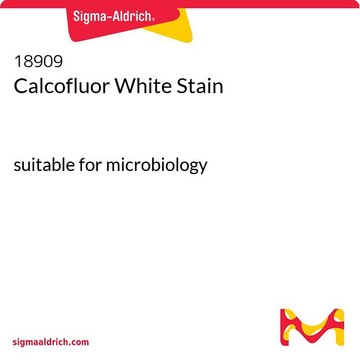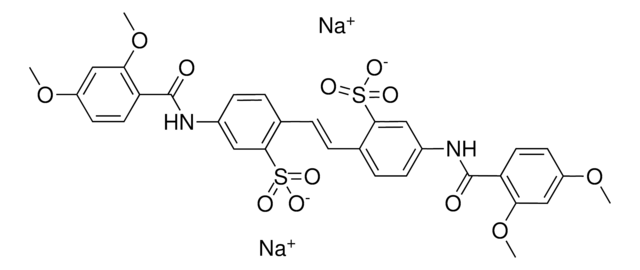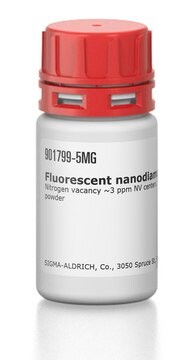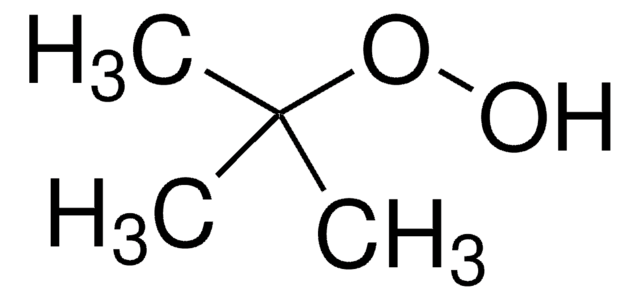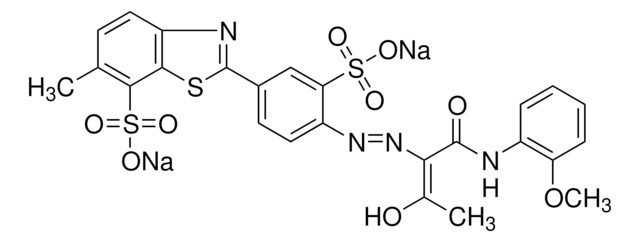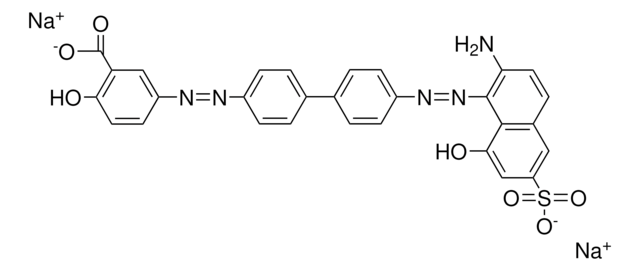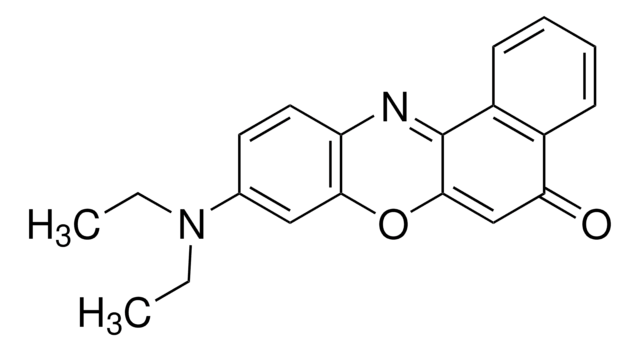Wichtige Dokumente
910090
Fluoreszierender Aufheller 28, Dinatriumsalzlösung
used as a stain and brightening agent
Synonym(e):
Fluoreszenz-Aufheller
About This Item
Empfohlene Produkte
Form
liquid
Konzentration
25% in water
SMILES String
[Na+].[Na+].OCCN(CCO)c1nc(Nc2ccccc2)nc(Nc3ccc(\C=C\c4ccc(Nc5nc(Nc6ccccc6)nc(n5)N(CCO)CCO)cc4S([O-])(=O)=O)c(c3)S([O-])(=O)=O)n1
InChI
1S/C40H44N12O10S2.2Na/c53-21-17-51(18-22-54)39-47-35(41-29-7-3-1-4-8-29)45-37(49-39)43-31-15-13-27(33(25-31)63(57,58)59)11-12-28-14-16-32(26-34(28)64(60,61)62)44-38-46-36(42-30-9-5-2-6-10-30)48-40(50-38)52(19-23-55)20-24-56;;/h1-16,25-26,53-56H,17-24H2,(H
InChIKey
YJHDFAAFYNRKQE-YHPRVSEPSA-L
Suchen Sie nach ähnlichen Produkten? Aufrufen Leitfaden zum Produktvergleich
Allgemeine Beschreibung
Anwendung
- Fluorescent Brightener 28 is used in microscopy as fluorochromes, especially to visualize plant tissues by binding to cellulose.
- It is used in microbiology for staining pathogenic fungi, fungal cell walls, Candida albicans biofilms, for the automated counting of bacteria and spores, and as a viability stain.
- It is a rapid method for the detection of many yeasts and pathogenic fungi such as Microsporidium, Acanthamoeba, Pneumocystis, Naegleria, and Balamuthia species.
- It is used industrially as a fluorescent brightening agent for cellulose and polyamide fabrics, paper, detergents, and soaps.
- It has been used in the identification and study of the structure and biosynthesis of chitin from the freshwater sponge Spongilla lacustris, and to elucidate the location of chitin in skeletal structures.
Biochem./physiol. Wirkung
Leistungsmerkmale und Vorteile
- Facilitates rapid detection of many pathogenic yeasts and fungi.
- As a brightening agent, its addition can offset the tendency of white materials to yellow with age.
Lagerklassenschlüssel
12 - Non Combustible Liquids
WGK
WGK 1
Flammpunkt (°F)
Not applicable
Flammpunkt (°C)
Not applicable
Hier finden Sie alle aktuellen Versionen:
Analysenzertifikate (COA)
Die passende Version wird nicht angezeigt?
Wenn Sie eine bestimmte Version benötigen, können Sie anhand der Lot- oder Chargennummer nach einem spezifischen Zertifikat suchen.
Besitzen Sie dieses Produkt bereits?
In der Dokumentenbibliothek finden Sie die Dokumentation zu den Produkten, die Sie kürzlich erworben haben.
Unser Team von Wissenschaftlern verfügt über Erfahrung in allen Forschungsbereichen einschließlich Life Science, Materialwissenschaften, chemischer Synthese, Chromatographie, Analytik und vielen mehr..
Setzen Sie sich mit dem technischen Dienst in Verbindung.